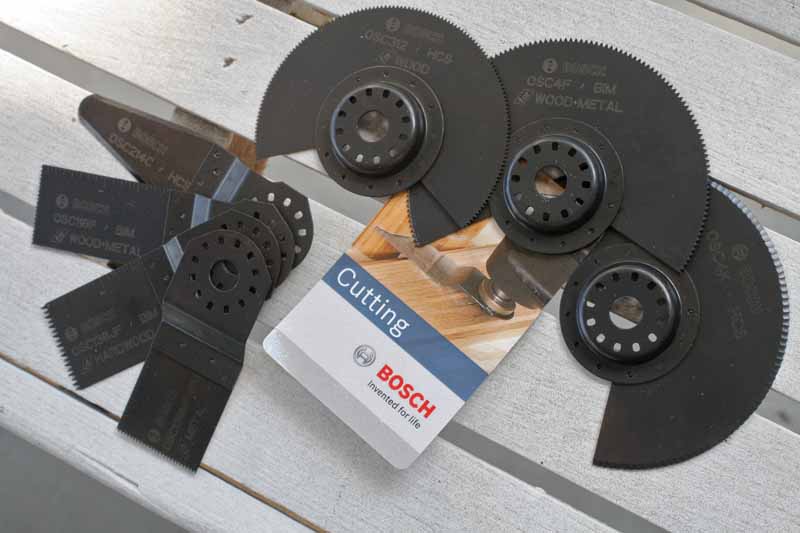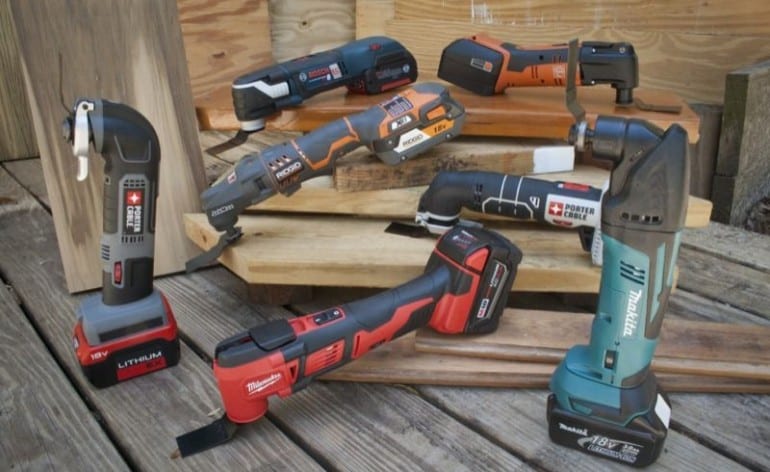The oscillating multi-tool is one of the handiest tools you can have around the jobsite or workshop. Its versatility lets you accomplish numerous tasks that would be impossible with other tools. You can sand; saw metal, wood, and drywall; make large holes; plunge cut into hardwood; or undercut a doorway. You can also remove grout, cut trim for new flooring, and cut off nails and screws flush. That’s just the start. We like our oscillating multi-tools so much that we compiled this list of 6 ways Pros use an oscillating multi-tool. And believe me, there’s more than five…And be sure to also check out our best oscillating multi-tool review.
How to Use an Oscillating Tool – The Basics
By way of overview, using an oscillating tool can’t be simpler. The tool rapidly vibrates a blade, scraper, or sanding pad back and forth. That action, coupled with the accessory yields a very fast motion for cutting, scraping, or sanding. Designed for smaller applications, a multi-tool does its best work in areas where accessibility is key.
Typically, when you need an oscillating multi-tool, no other tool will get the job done. Using an oscillating multi-tool simply involves attaching the appropriate accessory and turning it on. Originally, every tool had its own type of connection. More recently, the accessories and interfaces have begun to consolidate somewhat—leaving two major styles.
OIS Interface
The first dates back the furthest: the OIS interface. Bosch originally designed the OIS interface or Oscillating tool Interface System. It features a circle of slots that fit a large majority of tool pin sizes on the market.

With this interface, you use either a manual threaded mount or a tool-free interface mount to release the head and insert or remove the oscillating multi-tool accessory. Once you retighten or otherwise secure the accessory, you can begin or resume work.
Bosch (and Fein) Starlock Interface
The Bosch Starlock interface (a joint venture with Fein) uses a unique tool-free, hands-free system. You simply flip a lever to release the accessory or open the mount. Then, you physically press the oscillating multi-tool onto the new accessory which automatically snaps it into place.

By far, this system works the best. Accessory pricing seems in line with others, so you don’t pay much of a premium to get the benefits of the Starlock interface. You do, however, need to make sure you use both a Starlock-compatible tool and Starlock accessories for everything to work properly. Most Starlock accessories now come with OIS-compatible holes, however, no OIS accessories are compatible with Starlock due to the 3D “bottle cap” shape of the interface.
6 Professional Uses for an Oscillating Tool
1. Plunge Cutting
This is possibly our favorite of the 5 ways Pros use an oscillating multi-tool. The tool is designed for “impossible” plunge cuts. It makes them easy—if you use the right blade. While multi-tools are commonly used to cut holes in drywall for electrical boxes, they can tackle any job that needs a plunge cut. Begin a mortise. Make a notch. Cut trim and casings for flooring.

2. Using a Multi-Tool for Orbital Sanding
The action on an oscillating multi-tool gives it a sort of orbital sanding action when used over small areas. Swapping the blade attachment for the sanding attachment, you can use the oscillating multi-tool as a small detail sander. It’s not a replacement for other handheld sanders, but it will work for small areas. We like the control it gives us over the work. There’s also an abrasive attachment that’s good for removing small arms of grout or glue.

3. Straight Cuts in Wood, Drywall, and Metal
Swapping the attachment for a half-moon blade, you can easily make longer cuts in wood, drywall, and metal. You’ll be surprised at the ease of the cut. We did quite a bit of this in our Ridgid Jobmax Multi-tool review. The increased surface area of the half-moon blade helps you hold straight to a line while cutting quickly.

4. Using an Oscillating Multi-Tool to Strip, Peel, and Scrape
Old paint, that “beautiful” old linoleum floor, unidentifiable gunk, and more can be removed easily with a scraping blade for a multi-tool. I’m sure you can think of at least three places to use this function right now. You don’t want to use an oscillating multi-tool to scrape an entire floor, but for focused areas, it gets down to business. For larger areas use something like the Makita floor scraper.

5. Remove Grout and Caulk.
If you’ve ever experienced the joy of removing old grout and caulk for a bathroom remodel, you may not get to the end of this sentence before heading to the hardware store to buy a multi-tool. The oscillating feature makes this kind of work easy and efficient. The caulk will literally come right up, and experienced users will leave the material underneath largely unscathed.

6. Undercut Doors for Tile & Flooring
Perhaps the best way Pros use an oscillating multi-tool is for undercutting doors when tiling or flooring. We did quite a bit of flush-cutting when we did our Pergo Outlast laminate flooring review. Get a good Japanese tooth blade when going after hardwood trim, and you’ll be done in no time. If you suspect you might hit nails, opt for a carbide blade that can tackle wood and nails. Not only will it get the job done, but it should last for dozens of jobs.
The technique uses a tile or piece of wood which the tool sits atop. This sets the height of the undercut. Simply slide the tool blade to the material and make your cut and you can now slip the tile or flooring underneath the door for a beautiful fit that looks like it was perfectly coped.
Wrapping It Up
We hope you’ve gained useful knowledge from these 6 professional uses for an oscillating multi-tool. If you’re a Pro and have tips on using an oscillating multi-tool, add them in the comments below. You can also contact us or visit us on our social media channels.





I recently used mine to modify an old Dewalt electric screwdriver case for my multi-tool that didn’t come with its own case. It had thick plastic cutouts to form fit the designated tool. My multi-tool cut through them with ease. After inserting some foam, it now stores my multi-tool and spare attachments and blades safely and securely.
Use it to cut shingles after you lay it on the roof. Makes a clean cut with the right blades